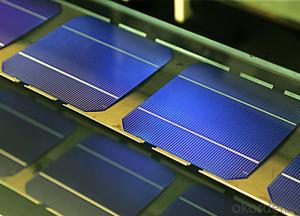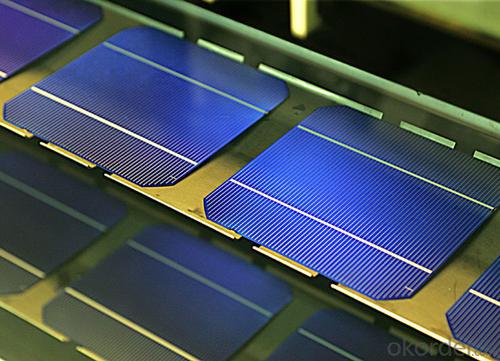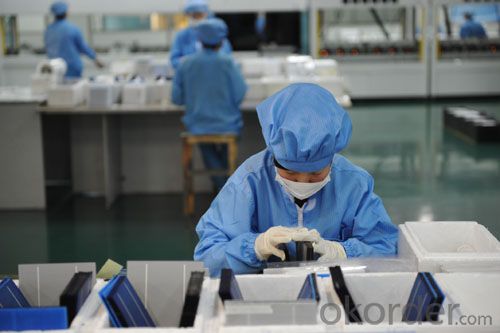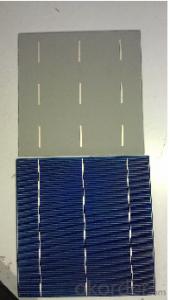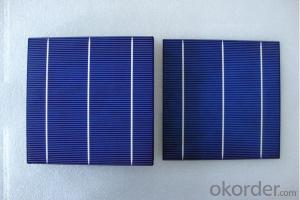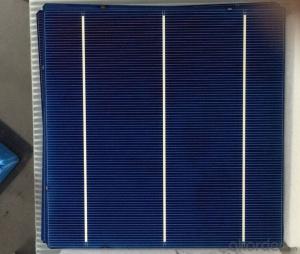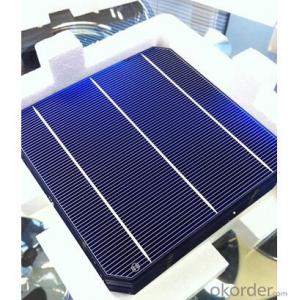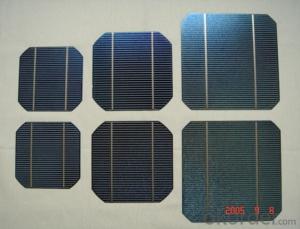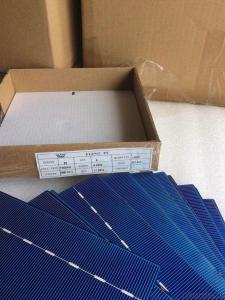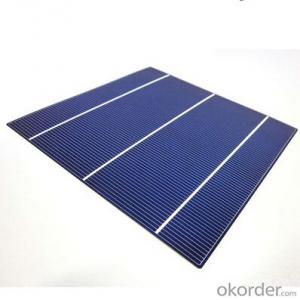Silicon Solar Cells - World-Beating Efficiency, 25-Year Lifespan, 17.2% Efficiency
- Loading Port:
- Shanghai
- Payment Terms:
- TT OR LC
- Min Order Qty:
- 1000 pc
- Supply Capability:
- 5000000 pc/month
OKorder Service Pledge
OKorder Financial Service
You Might Also Like
Brief Introduction of Solar Cells
A solar cell, is an electrical device that converts the energy of light directly into electricity by the photovoltaic effect, which is a physical and chemical phenomenon. It is a form of photoelectric cell, defined as a device whose electrical characteristics, such as current, voltage, or resistance, vary when exposed to light. Solar cells are the building blocks of photovoltaic modules, otherwise known as solar panels.
Introduction of our Company
Our company is dedicated to the research, development, and manufacture of high quality solar products and services, ranging from Photovoltaic (PV) cells, PV modules, to PV power systems. Over these years, we has been expanding solar expertise across the value chain to give our customer the advantage of international sourcing and manufacturing. Being the largest professional solar cell manufacturer in the world, we offer enhanced solar cell technology to customers with better quality and operational efficiency.
Since our founding in 1981, we evolved from a test and measurement instruments designer and manufacturer to a full service global solar company. In 1997 our Division was established. In 2000, we began producing solar cells and pioneered the manufacturing and marketing of high-quality mono and multi-crystalline silicon solar cells in Taiwan while offering our products across the globe. The business unit of test and measurement instruments was then called Instruments Division. Due to our business expansion, our official company name was changed to Industries, Inc. from the original Meter International Corporation.
In 2010, we achieved over 1.2GW production capacity with nearly 1GW total output, and reached to 2.0GW in the year of 2014. With the honor of this outstanding performance, wehas been listed in the one of the top global cell manufacturers over years.
Specifications of Polycrystalline Solar Cells
Format : 156 mm × 156 mm ± 0.5 mm
Thickness: 210 μm ±40 μm
Front (-) : 1.5mm bus bars (silver),blue anti-reflection coating (silicon nitride)
Back (+) : 2.5mm wide soldering pads (silver) back surface field (aluminium)
Efficiency (%) | Pmpp (W) | Umpp (V) | Impp (A) | Voc (V) | Isc (A) |
18.00% | 4.38 | 0.528 | 8.291 | 0.631 | 8.869 |
17.80% | 4.33 | 0.525 | 8.252 | 0.629 | 8.821 |
17.60% | 4.29 | 0.532 | 8.053 | 0.633 | 8.541 |
17.40% | 4.23 | 0.528 | 8.092 | 0.624 | 8.632 |
17.20% | 4.19 | 0.524 | 7.992 | 0.62 | 8.458 |
17.00% | 4.14 | 0.52 | 7.972 | 0.623 | 8.5 |
Advantage of Polycrystalline Solar Cells
1. Tire-1 Solar Cells’ Manufacturer Quality Guarantee. With a complete and sophisticated quality government system, our Quality Management have arrived world’s leading place. Customer can receive Tire-1 Cells Maker’s Quality Standard Products.
2. Trusted Warranty. We can supply trusted after-sales service to our customer. If our cells are found not in conformity to the specification of manufacturer, or should the inspected quantity found in shortage, or should the packing found damaged, the buyer has the right to claim to the seller. The claim, if any, should be presented to seller within 30 days after cargo's arrival date to the port, together with related inspection report and photos issued and provided by a reputable independent surveyor such as SGS.
3. World’s Leading Manufacturer Equipment. We imported the newest and leading production equipment from abroad. Advanced equipment can guarantee the stable quality of cells. Auto production line can also save labor cost which will further cut our production cost.
4. Bulk supply: With the production capacity of 500MW, we can produce large quantity every month. This can satisfy most customer requirement.
Usage of Polycrystalline Solar Cells
Solar cells are often electrically connected and encapsulated as a module. Photovoltaic modules often have a sheet of glass on the front (sun up) side, allowing light to pass while protecting the semiconductor wafers from abrasion and impact due to wind-driven debris, rain, hail, etc. Solar cells are also usually connected in series in modules, creating an additive voltage. Connecting cells in parallel will yield a higher current; our solar cells have passed IEC Certification. With high and stable quality, our cells can greatly improve the performance of Solar Modules.
Applications of Polycrystalline Solar Cells
Assemblies of photovoltaic cells are used to make solar modules which generate electrical power from sunlight, as distinguished from a "solar module" or "solar panel". A solar array generates solar power using solar energy.
Packaging & Delivery of Polycrystalline Solar Cells
Carton Box Package and Deliver by air. It should be noticed that it should be avoid of water, sunshine and moist.
Factory Picture of Solar Cells

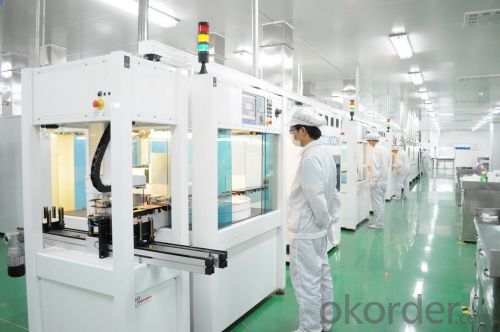
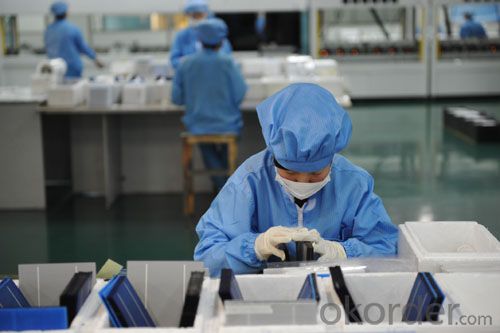
FAQ
We have organized several common questions for our clients,may help you sincerely:
1. What’s price per watt?
A: It’s depends on the quantity, delivery date and payment terms of the order. We can talk further about the detail price issue. Our products is high quality with lower price level.
2. Can you tell me the parameter of your solar cells?
We have different series of cells with different power output, both from c-si to a-si. Please take our specification sheet for your reference.
3. How do you pack your products?
We have rich experience on how to pack the panels to make sure the safety on shipment when it arrives at the destination.
4. Can you do OEM for us?
Yes, we can.
5. How long can we receive the product after purchase?
In the purchase of product within three working days, We will arrange the factory delivery as soon as possible. The perfect time of receiving is related to the state and position of customers. Commonly 7 to 10 working days can be served.
- Q: How do solar cells impact air pollution?
- Solar cells have a significant positive impact on air pollution as they generate clean, renewable energy without emitting harmful pollutants or greenhouse gases. By reducing our reliance on fossil fuels, solar cells help mitigate air pollution and improve the overall air quality, leading to better health outcomes and a healthier environment.
- Q: How do solar cells perform in areas with limited space for installation?
- Solar cells can still perform efficiently in areas with limited space for installation through the use of innovative technologies such as rooftop and building-integrated photovoltaics. These systems maximize the use of available space, allowing solar cells to generate electricity even in compact urban environments. Additionally, advancements in solar cell design and efficiency have made it possible to produce more power from smaller areas, further optimizing electricity generation in limited spaces.
- Q: Can solar cells be used for powering electric vehicles charging stations?
- Yes, solar cells can be used to power electric vehicle charging stations. Solar panels can convert sunlight into electricity, which can then be used to charge electric vehicles. This helps to utilize renewable energy sources and reduce the carbon footprint associated with charging electric vehicles.
- Q: Can solar cells be used for heating?
- Yes, solar cells can be used for heating through the use of solar thermal collectors. These collectors capture the sun's energy and convert it into heat, which can then be used for various heating purposes such as heating water or indoor spaces.
- Q: Can solar cells be damaged by hail or other weather conditions?
- Yes, solar cells can be damaged by hail or other severe weather conditions. Hailstones or strong winds can cause physical damage to the surface of solar panels, leading to cracks or breakages. Additionally, extreme heat or cold can affect the efficiency and lifespan of solar cells. Therefore, it is important to consider the weather conditions and install appropriate protection measures to safeguard solar panels.
- Q: What is the impact of dust and dirt on solar cell performance?
- The presence of dust and dirt on solar cells can significantly impact their performance. These particles can accumulate on the surface of the cells, reducing the amount of sunlight that reaches the photovoltaic material. This reduces the efficiency of the solar cells in converting sunlight into electricity. Dust and dirt can also create shadows on the cells, causing hot spots and leading to uneven distribution of power production. Therefore, regular cleaning and maintenance of solar panels are crucial to maximize their performance and ensure optimal energy generation.
- Q: Can solar cells be used in grid-tied systems?
- Yes, solar cells can be used in grid-tied systems. In a grid-tied system, solar cells generate electricity from sunlight and feed it directly into the electrical grid. This allows homeowners or businesses to offset their energy consumption and even earn credits for excess electricity produced, making it an efficient and sustainable option for renewable energy integration.
- Q: Do solar cells work at night or in low light conditions?
- No, solar cells do not work at night or in low light conditions as they rely on sunlight to generate electricity.
- Q: Can solar cells be used for powering remote research stations in Antarctica?
- Yes, solar cells can be used for powering remote research stations in Antarctica. Solar energy is a renewable and sustainable source of power, making it an ideal choice for off-grid locations such as Antarctica. With advancements in technology, solar panels can efficiently generate electricity even in extreme cold conditions, making them a reliable source of energy for remote research stations in Antarctica.
- Q: How are solar cells installed on rooftops?
- Solar cells are typically installed on rooftops using a mounting system that secures the panels in place. This involves attaching metal brackets or rails onto the roof, which act as the support structure for the solar panels. The panels are then placed onto these brackets and secured using clamps or screws. The installation process requires careful positioning and alignment to ensure maximum sunlight exposure for efficient energy generation.
Send your message to us
Silicon Solar Cells - World-Beating Efficiency, 25-Year Lifespan, 17.2% Efficiency
- Loading Port:
- Shanghai
- Payment Terms:
- TT OR LC
- Min Order Qty:
- 1000 pc
- Supply Capability:
- 5000000 pc/month
OKorder Service Pledge
OKorder Financial Service
Similar products
Hot products
Hot Searches
Related keywords
